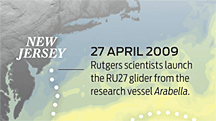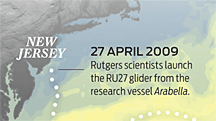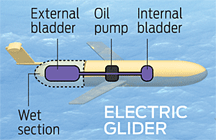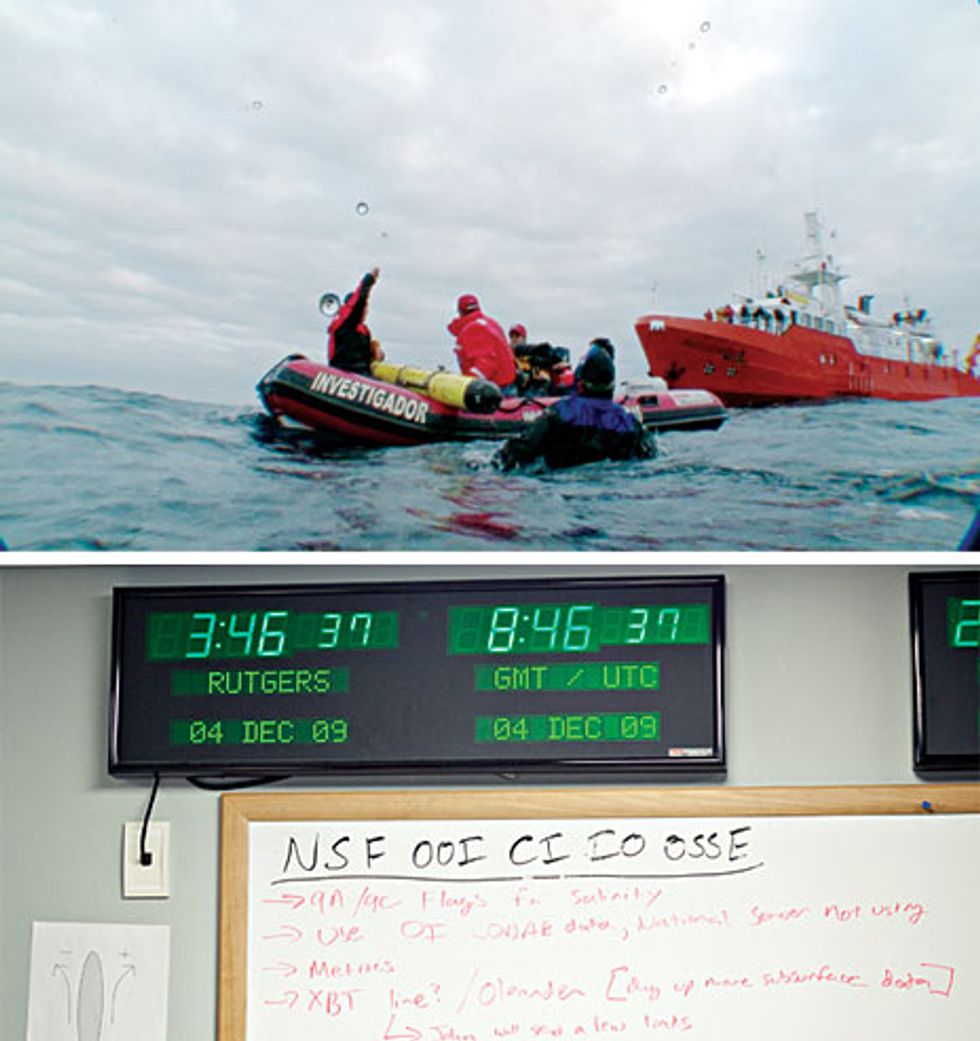Remotely Piloted Underwater Glider Crosses the Atlantic
Rutgers University's underwater vehicle successfully navigates an ocean

About 48 kilometers off the eastern coast of the United States, scientists from Rutgers, the State University of New Jersey, peered over the side of a small research vessel, the Arabella. They had just launched RU27, a 2-meter-long oceanographic probe shaped like a torpedo with wings. Although it sported a bright yellow paint job for good visibility, it was unclear whether anyone would ever see this underwater robot again. Its mission, simply put, was to cross the Atlantic before its batteries gave out.
Unlike other underwater drones, RU27 and its kin are able to travel without the aid of a propeller. Instead, they move up and down through the top 100 to 200 meters of seawater by adjusting their buoyancy while gliding forward using their swept-back wings. With this strategy, they can go a remarkably long way on a remarkably small amount of energy.
When submerged and thus out of radio contact, RU27 steered itself with the aid of sensors that registered depth, heading, and angle from the horizontal. From those inputs, it could ”dead reckon” about where it had glided since its last GPS navigational fix: Every 8 hours the probe broke the surface and briefly stuck its tail in the air, which exposed its GPS antenna as well as the antenna of an Iridium satellite modem. This allowed the vehicle to contact its operators, who were located in New Brunswick, N.J., in the Rutgers Coastal Ocean Observation Lab, or COOL Room.
Modeled after NASA’s command center in Houston, the COOL Room is lined with computer consoles and plasma displays. They indicate, among other things, the locations of various research vessels and remote-controlled gliders working the world’s oceans. Whenever researchers call them up, other nautically relevant charts also dance across the screens, showing, for example, sea-surface temperatures, currents, winds, and cloud cover.
On the day of the launch—27 April 2009—the COOL Room was packed with students, scientists, and technicians, all clinging to the sounds radioed in from the Arabella. When Scott Glenn, leader of the shipboard science team, applauded RU27’s safe passage into the sea, the throng in the control room followed suit. It was one small step for a machine, on what was to be one giant transatlantic leap for mankind.
But mere minutes into the mission, during an initial test dive, it became clear that something was seriously amiss. RU27 was diving too slowly and ascending too quickly. Had somebody forgotten to install one of the extra battery packs, making the glider more buoyant than expected? Unless the cause could be found and rectified, RU27 would have to be plucked from the Atlantic and returned to Rutgers for disassembly and troubleshooting.
A tense half hour passed while the glider completed another test dive. Finally, the Arabella team pinpointed the problem—a hastily mistyped minus sign instead of a plus sign in one of the guidance parameters sent to RU27’s onboard computer. ”It’s nice that it does exactly what it’s told, even if it’s wrong,” Glenn said.
Once that wrinkle was ironed out, researchers in the COOL Room took control of the glider. Tina Haskins, a Rutgers technician who had helped to assemble the glider, surveyed RU27 from the deck of the Arabella while the little yellow submarine drifted close to the ship. ”All right, bid farewell!” she called out. ”This is the last time we’ll see her on the surface for a while.” And with those words still floating in the air, RU27 silently dove beneath the waves.
RU27 is just one of more than 100 gliders doing important oceanographic work all over the world. They are designed and built by a handful of companies and research groups. The maker of RU27, Teledyne Webb Research, of East Falmouth, Mass., is the largest supplier of these unique oceanographic robots. Their up-and-down zigzagging lets scientists survey the upper part of the ocean, which is otherwise largely invisible to them.
Satellites track only the sea surface, and most measurements of conditions at depth come from sensors attached to a few thousand floating oceanographic probes that drift wherever the currents take them. To examine targeted areas, oceanographers can lower instruments from research vessels, but such ships have limitations. They cannot be used to investigate the oceanographic effects of violent storms, for example—at least not intentionally. Also, research vessels rarely remain at sea for longer than a month or so at a time, and they’re extraordinarily expensive to operate.
Remote-controlled gliders suffer from none of these constraints. They are inexpensive and require no crew or support ship (except while they’re being deployed or recovered), making them a cost-effective way to survey large swaths of the upper ocean.
But oceanographic gliders don’t just study the sea: Some, known as thermal gliders, can also use the ocean’s energy as a source of power. They do so by taking advantage of the temperature difference between the surface, which is warmed by the sun, and the ocean’s chilly depths.
To understand how a thermal glider works, imagine for a moment that you’ve filled a garbage bag with tap water and then frozen the entire mass. Next, you attach a good-size lead sinker to it and plop it into the ocean. After bobbing around on the surface for a while, the ice would melt, and the weighted bag would sink. Now, consider what would happen if the seawater surrounding the sinking mass became cold enough to freeze the water in the bag. Ice would re-form, and the bag would float to the surface, lead sinker and all, whereupon the cycle would start all over again. If this contraption had wings, it could also glide forward as it yo-yoed up and down.
To see a bigger version of the slideshow, view it here: "Underwater Glider Arrives in Spain"
This little thought experiment is a radical simplification of how a thermal glider actually works. Real thermal gliders don’t contain bags of ice; they use a substance that changes from solid to liquid at a higher temperature. And they employ a complex arrangement of internal reservoirs, bladders, and gas chambers to adjust their buoyancy. It’s a clever way to tap nature’s energy at sea, but the technology is still in its infancy. Teledyne Webb Research has built only a half-dozen thermal gliders, some of which are now undergoing sea trials.
RU27 uses a simpler system—an electrically operated piston, which displaces a small amount of seawater to adjust the sub’s buoyancy. Other electric gliders adjust their buoyancy using a motor to pump oil in and out of a seawater-displacing bladder [see illustration, left,"Electric vs. Thermal Gliders"]. This doesn’t allow for the kind of multiyear operations that are envisioned for thermal gliders. But even so, the Rutgers oceanographers calculate that their electric gliders are something like a thousand times as efficient as a typical automobile in terms of energy expended for each kilometer traveled.
As these gliders move, they use thermistors to measure the temperature of the sea around them and conductivity sensors to gauge how salty the water is. These readings help oceanographers determine how the upper portion of the sea stores heat and moves that heat around, which plays into discussions about global climate change.
A glider’s payload bay can be crammed with other sorts of scientific instrumentation as well—optical sensors for measuring water clarity and the density of microscopic plants called phytoplankton, hydrophones for recording whale vocalizations and other sounds of the sea, and chemical sensors for tracking dissolved nutrients, to name but a few examples. All this information is relayed in near real time to scientists, who can use it to refine computer models of oceanic circulation and to decide where the glider will go next.
When it comes to monitoring the ocean, then, these little robotic subs can pack quite a punch, which is why the data they transmit are so valuable and why a glider’s long-term survival is so important—and not to be taken for granted.
The Rutgers team learned this the hard way a year earlier when RU17, a different glider with the same transatlantic mission, ”died a hero’s death,” as Oscar Schofield, a Rutgers oceanographer, put it. RU17 foundered just off Portugal’s Azores islands, more than 3000 km from its point of origin. It might have sprung a leak, or one too many remoras (a kind of suckerfish) may have attached themselves to the glider and weighed it down. Whatever the reason, when RU17 sank, so did the spirits of the team that had assembled and piloted it, making them even more tense during this second try.
Each month of RU27’s journey supplied a fresh batch of maritime adventures. Schofield said that waiting for the glider’s regular satellite calls was like waiting for one of his teenage daughters to phone home and check in. Each time the glider failed to ring the COOL Room on schedule, the team fretted as if for a lost child, poring over logs and command histories until the scientists finally got the call they’d been anticipating.
One early goal of the mission was to have RU27 hitch a ride on the Gulf Stream, a fast-moving current that originates in the Gulf of Mexico and travels partway up the East Coast of the United States before shooting directly toward the other side of the Atlantic. To reach these quick-moving waters, the team planned to take advantage of warm-core rings, large masses of warm water swirling around in the otherwise cold seas north of the Gulf Stream. The idea was to steer RU27 into such a ring, where it would be swept along on a circular course toward the fast eastward flow. That was the plan, anyway. But by the time the researchers were ready to put it into action, there were no rings to be found. Instead, the scientists had to rely on currents of a much smaller scale, which were harder to navigate. But finally, the controllers managed to get the glider into the Gulf Stream, which sent it clipping along at 7 km per hour, seven times as swiftly as it could travel by itself.
Haskins claims that each of the gliders she works with has its own personality, noting that RU27 ”seems so much faster and more agile than our other gliders, [allowing it] to use currents more favorably.” Yet by late August, after coasting with the Gulf Stream and then maneuvering through weaker seas, RU27 began to seem awfully slow. The glider was nearing the Azores, and the team dreaded a repeat of RU17’s demise. Something had to be done. So Haskins and two other technicians flew to the Azores to find out what was wrong.
They spent five days aboard a hastily chartered boat and traveled more than 300 km out to sea searching for RU27. Once they located the glider, Haskins and her colleagues jumped into the water to examine it. Understandably, they didn’t want to bring it aboard the ship, which would have turned the transatlantic trek into two less-than-record-breaking legs. But they didn’t have to. Haskins discovered that the seams in the glider’s hull were covered with hundreds of gooseneck barnacles. Their extra drag had slowed the glider and made it hard for it to maneuver. Haskins and her coworkers removed the barnacles, and before long the glider was again winging its way toward Spain.
Although the Rutgers researchers used RU27 to collect oceanographic data, their primary motivation for the mission wasn’t scientific. Rather, they wanted to test the machine’s limits, garner publicity, and generate goodwill for the kind of work the scientists are doing. If pure oceanographic research had been their objective, they wouldn’t have made certain sacrifices to complete the long voyage, replacing many of the usual sensors with extra battery packs and limiting data collection to just 1 hour a day to conserve energy.
Because undergraduates had been so involved in piloting the submarine, it’s fair to say that RU27 served more as a teaching aid than as a research tool. The vessel also became something of a transatlantic emissary. In addition to its many extra batteries, it carried 200 letters written by schoolchildren from all over the United States. The idea was that those letters would be given to Spanish schoolchildren who would then become the Americans’ pen pals.
RU27 would solidify some links between grown-ups, too. On the second half of the voyage, Rutgers scientists began relying on Spanish colleagues at the University of Las Palmas, in the Canary Islands, for oceanographic data to help guide the glider through the eastern half of the Atlantic. Scientists at the University of the Azores helped, too, as did oceanographers working with the Spanish Port System. So in early December 2009, when Glenn met with some of his Spanish colleagues for the first time to coordinate the recovery of the glider, he felt as though he were seeing old friends.
On 3 December 2009, Glenn, a handful of others from Rutgers, and Clayton Jones, senior director of glider development at Teledyne Webb Research, boarded the research vessel Investigador, which left the Spanish port of Vigo and within 20 hours maneuvered to within just a few kilometers of the heroic little sub. The night was pitch black, and the seas were calm.
Back in New Jersey, the COOL Room wasn’t nearly as placid—indeed, it looked like the site of a science slumber party. The Rutgers oceanographers, their students, and various other hangers-on were killing time gabbing about oceanography while chomping on bananas and chocolate doughnuts. Everyone was staying up late to learn more about the glider, which had already caused a good number of sleepless nights.
At 3:13 a.m., the speakerphone in the COOL Room crackled to life: On the Spanish ship, Glenn announced that they’d spotted the glider. After hauling it aboard a small inflatable skiff, they gingerly hoisted the boat and glider onto the Investigador. Raucous applause erupted in the COOL Room as backs were patted and high fives given, rivaling the fervor displayed at mission control in Houston during an Apollo-era splashdown.
As with those moon missions, not all that much science had been done. Still, the little glider had just made history: It was the first remote-controlled object to cross an ocean underwater—admittedly, with a barnacle-cleaning pit stop along the way. The little robot’s 221-day voyage had taken it 5300 km as the crow flies. So it was time for the Rutgers scientists to celebrate. The festivities were just as lively off the coast of Spain aboard the Investigador, where RU27 soon found itself dripping wet again, this time not with seawater but with champagne.
This article originally appeared in print as "Yellow Submarine."
To Probe Further
Interested readers can experience an audio slideshow on RU27’s voyage.


